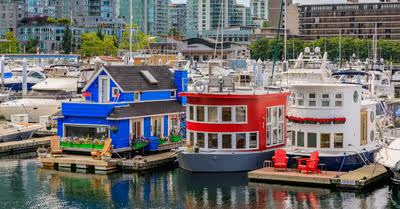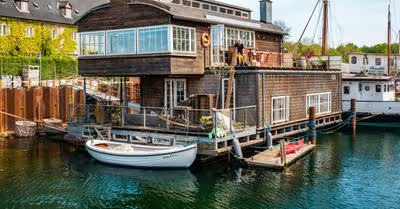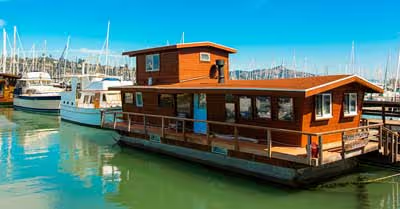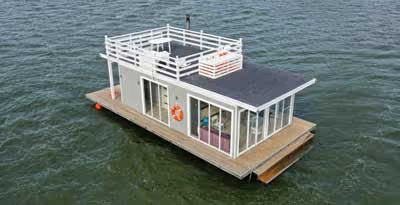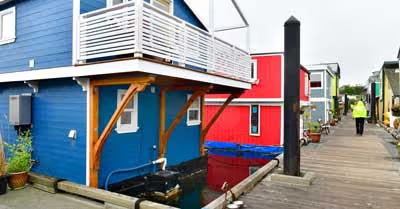
The rising cost of housing in America makes the idea of living on a houseboat increasingly attractive. But is it cheaper to live on a houseboat?
Compared to a suburban home, living on a houseboat saves an average of $996 per month. The initial purchase price of a houseboat is also less than a conventional home. Additional expenses, such as property taxes and HOA fees, usually don't apply either.
In this article, we'll compare the cost of living on a houseboat to a traditional home. We'll go over purchase price, maintenance, docking costs, and other houseboat living considerations. We will also cover additional expenses, such as transportation and utilities.
We sourced the information for this article from houseboat guides and from people who live aboard houseboats. Additionally, we sourced data from state and local living cost statistics.
Houseboat vs. Suburban Home
Making a direct comparison between houseboats and suburban homes is difficult, as there are many different kinds of houseboats. Some houseboats are designed to resemble recreational vessels closely. These boats are typically made of fiberglass and shaped somewhat aerodynamically. In other words, they don't resemble a house.
Pre-manufactured houseboats (of the variety mentioned previously) are not comparable the suburban homes in design or cost. These vessels are easier to compare to sailboats or powerboats.
In this article, we're going to focus on the other kind of houseboat. A typical houseboat is, in most cases, quite literally a house on top of a boat. These are stick-built homes constructed on barges or pontoons, and they're easily comparable to traditional suburban homes.
Stick-built houseboats are almost indistinguishable from typical suburban homes, as they're constructed the same way. The primary difference, other than the foundation, is with plumbing and utilities. Houseboats must be fully self-contained and can't rely on permanent piping or wiring. These homes are connected to shore utilities via cables and flexible hoses.
Are Houseboat Mortgages Cheaper?
The first cost consideration is the mortgage. Suburban homeowners pay mortgages, which often last between 15 and 30 years. Houseboats usually aren't this way, as they are significantly less expensive to construct and purchase.
This is partially due to their size, as houseboats are rarely as large as typical suburban homes. Typical houseboats range in size from 400 to 1,000 square feet on average, whereas the typical American suburban home is between 1,600 and 3,000 square feet.
Some people cover the cost of their houseboat in cash, or they build it themselves to save money. Another consideration is that houseboats float, and therefore don't require land or property. Since property is expensive, houseboat owners save significant amounts of money by avoiding it altogether.
Houseboat Utility Costs
As you might expect, utility costs are cheaper for houseboats than they are for suburban homes. This, again, is due primarily to their size. It costs a lot less to heat and cool a 1,000 square foot home than a 3,000 square foot home.
If we assume the average cost to heat and cool a house is $2.50 per square foot, your annual savings on a houseboat would range between $1,500 and $5,000 per year. Those savings are significant, especially if you live in an area with extreme temperatures or high energy costs.
Due to their self-contained nature, it's also easier to install alternative energy systems on a houseboat than in a traditional home. Solar panels and wind turbines can further reduce your energy bills, making up for the initial investment and just a few short years.
Property Taxes
Tax savings are a big plus to living on a houseboat. In most states, property taxes only apply to land-based property. Just like the riverboat casinos in New Orleans, houseboats get around the rules with a floating exemption. They're not on land, so property taxes don't apply.
In states like Texas, where property taxes make up for the lack of an income tax, houseboat residents can make the most of their salaries by avoiding the highest state taxes altogether. Keep in mind that there are some exceptions to this rule, and you may have to pay some sort of tax for living on a houseboat.
Docking and Slip Fees
There is one category where traditional suburban homes have a cost advantage over houseboats. This is docking and slip fees, as you'll need to find a place to park your houseboat.
Some people are lucky enough to work out an arrangement with the city or a property owner, but the vast majority of houseboat owners pay some sort of marina to tie up and connect to utilities.
Luckily, docking and slip fees are usually much less expensive than rent or property taxes. On average, you can expect to pay between $200 and $1,000 per month to dock your houseboat, and sometimes utilities are included in the price.
One drawback of houseboats compared to sailboats or power boats is that there are fewer suitable locations to dock. Houseboats are wider than recreational boats, so they require larger slips. They're also not seaworthy, so they can only dock safely in protected inland channels, lakes, and harbors.
Maintenance
According to two experts, a good rule of thumb is to budget 1% of your home's total value for maintenance each year. According to that metric, the average annual maintenance cost Suburban home is about $2,767 per year.
Boats are notoriously expensive to maintain. With that in mind, we'll apply the same rule to the average houseboat with an additional 10% on top for marine-related expenses. That makes the total houseboat maintenance cost $550. Houseboat owners can save an average of $2,217 per year on home maintenance.
Homeowner's Association (HOA) Fees
Homeowners associations can be helpful or harmful. Regardless of where you stand on HOAs, one thing is certain: they cost a lot of money. The average HOA fee is $250 per month. Houseboat HOAs generally don't exist, so we can eliminate this expense (and its associated rules) entirely.
Houseboat and Home Costs Compared
Here, we'll make a comprehensive cost comparison between the average houseboat and the average suburban home. The first cost to consider is the initial purchase price, which is often the greatest expense associated with homeownership.
According to Zillow, the average American home value in 2021 is $276,717. According to Neighbor, the average houseboat purchase price is a mere $50,000 resulting in an average savings of $226,717.
If we assume the monthly cost of utilities is around $160 for a liveaboard boat, it's reasonable to assume that the same Shore hookups would cost about 20% more for a larger stick-built houseboat. The average home utility cost is $364 per month, so you can expect to save around $172 per month living on a houseboat.
As you can see, living on a houseboat can save an average of $996 per month. That's not even including the cost of a mortgage or monthly payments, as the purchase price of a houseboat is usually hundreds of thousands of dollars cheaper than a typical suburban home.
Houseboats Costs that Exceed Traditional Homes
The only areas where houseboats have a disadvantage are transportation, registration, and slip fees. Most houseboats don't have a designated garage, so many houseboat owners have to pay to park their cars.
Boat registration also applies, but this rarely costs more than a few hundred dollars. Docking and slip fees, covered earlier, still cost far less than all the other expenses associated with homeownership.



